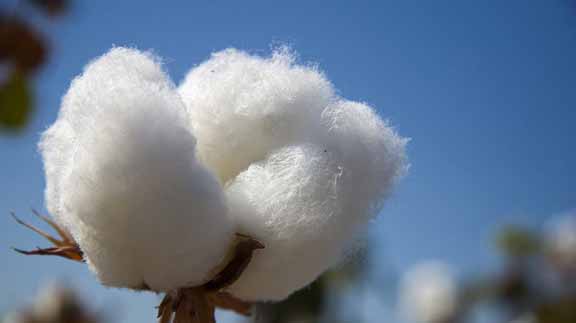Farm & Ranch
[AgriLife Today] Expert: Cotton prices to remain flat heading into 2015 due to large world supply

By: Blair Fannin
Writer: Blair Fannin, 979-845-2259, [email protected]
Contact: Dr. John Robinson, 979-845-8011, [email protected]
BRYAN – Cotton prices are projected to remain flat heading into 2015 as China continues to hold large supplies of cotton and consumption rates remain low, according to a Texas A&M AgriLife Extension Service cotton economist in College Station.
Dr. John Robinson gave a cotton outlook presentation at the 26th Texas Plant Protection Association Conference in Bryan recently.
“The cotton market is not booming as yarn prices remain flat,” Robinson said. “We’re not in a recession, but in a period of low growth and modest consumption. We don’t see anything that would pull up cotton prices in the near term.”
Robinson said speculative funds have been swinging from net short to neutral, and cotton futures have just hung in there around 60 cents.
Consequently, cotton has been ranging in the mid to upper 60s, he said.
For now, Chinese policy is one of the major influencers of the market, Robinson said.
“That, and the fact that more of the Chinese new crop cotton and reserves are getting used by China rather than buying U.S. exports continues to weigh heavily on market prices,” he said.
“If you have cotton in the loan, I would think about selling it and maybe use a call option strategy,” he said. “The end of the year carryover is projected to be more than 4 million bales. That’s more than enough cotton to fulfill demand.”
The 2015 outlook has projections of 15 million to 16 million bales produced in the U.S., he said.
“We will still plant plenty of acres despite projections of fewer planted acres,” Robinson said. “At least 15 million bales of production is projected for 2015.I don’t see any reason for new crop prices to be higher than old crop prices.”
Meanwhile, during the association’s awards luncheon, the Norman Borlaug Lifetime Achievement Award was given posthumously to the family of Dr. Tom Cothren, a longtime Texas A&M AgriLife plant physiologist. Cothren came to Texas A&M in 1982 after serving on the faculty at the University of Arkansas. He received many honors during his years of teaching and research, including Fellow of American Society of Agronomy, Fellow of Crop Science Society of America, Outstanding Research Award in Cotton Physiology and the Special Achievement Award for Teaching from Texas A&M. He also served on the Faculty Senate at Texas A&M.
Texas A&M students were also well represented in the poster competition. First place winner was graduate student Kate Harrell from the department of entomology. Graduate student Kevin Cox from the department of plant pathology and microbiology was second place winner, and third place went to Blake Baumann in the department of soil and crop sciences. Josh McGinty and Silvano Ocheya received graduate student awards.
Texas A&M AgriLife Extension Service horticultural specialist Dr.Joe Masabni received the association’s Academic-Agency Award. AgriLife Extension cotton program specialist Dale Mott, who served as association president for 2014, captured third place in the pest identification contest. Gary Bradshaw, consultant from Richmond, captured first place, while Webb Wallace, consultant from Harlingen, was awarded second place.
Larry McAnally received the TPPA Consultant Award. Donnie Dippel, president of the Texas Ag Industry Association, received the Ray Smith Leadership Award.
-30-
Farm & Ranch
Hazards of Backyard Poultry

By Barry Whitworth, DVM
Having backyard poultry is a popular agriculture enterprise. According to the United States Department of Agriculture, 0.8 percent of all households in the United States have chickens. People keep chickens for a variety of reasons with table eggs being one of the more common reasons.
Unfortunately, some of these poultry producers are not aware of the hazards that come with keeping poultry because many times they carry pathogens but appear healthy.
Chickens are carriers of several zoonotic diseases. These are diseases that can be passed from animals to humans. According to a recent survey in Pennsylvania, a majority of backyard poultry producers were aware of the dangers of avian influenza. However, this study also revealed that far fewer producers were aware of the risk of possible exposure to Salmonella and Campylobacter.
The lack of knowledge about the hazards of raising poultry likely contributes to the continued issues of Salmonella outbreaks associated with backyard poultry. In 2023, the Centers for Disease Control and Prevention reported 1,072 illnesses of Salmonella linked to backyard poultry, and 272 of those patients required hospitalization. Oklahoma reported 43 individuals with the disease.
To read more, pick up a copy of the April issue of NTFR magazine. To subscribe by mail, call 940-872-5922.
Farm & Ranch
Ag Elsewhere: Wyoming

By Tressa Lawrence
Babies are tucked away in every nook and cranny. Many ranchers across Wyoming have baby animals popping up all over this time of year.
Farm & Ranch
Ag Elsewhere: Montana

By Lindsey Monk
Another load of grain in to keep feeding the calves until the green grass can really start popping.
-

 Country Lifestyles1 year ago
Country Lifestyles1 year agoScott & Stacey Schumacher: A Growth Mindset
-

 Equine7 months ago
Equine7 months agoThe Will to Win
-

 Country Lifestyles7 years ago
Country Lifestyles7 years agoStyle Your Profile – What your style cowboy hat says about you and new trends in 2017
-

 Country Lifestyles4 years ago
Country Lifestyles4 years agoAmber Crawford, Breakaway Roper
-

 HOME7 years ago
HOME7 years agoGrazing North Texas – Wilman Lovegrass
-

 Country Lifestyles7 years ago
Country Lifestyles7 years agoDecember 2016 Profile, Rusty Riddle – The Riddle Way
-

 Country Lifestyles8 years ago
Country Lifestyles8 years agoJune 2016 Profile – The man behind the mic: Bob Tallman
-

 Outdoor9 years ago
Outdoor9 years agoButtercup or Primrose?






